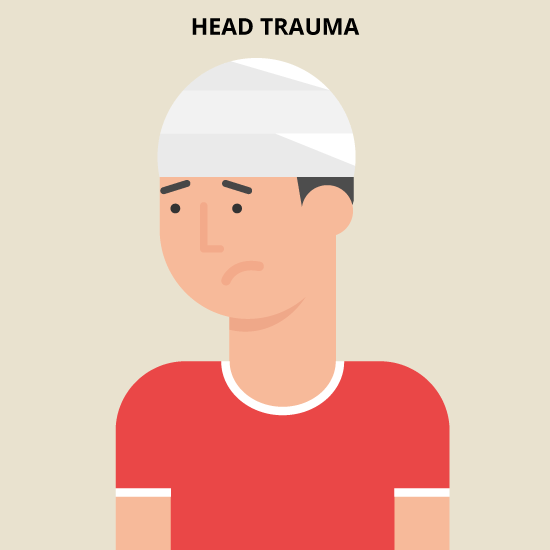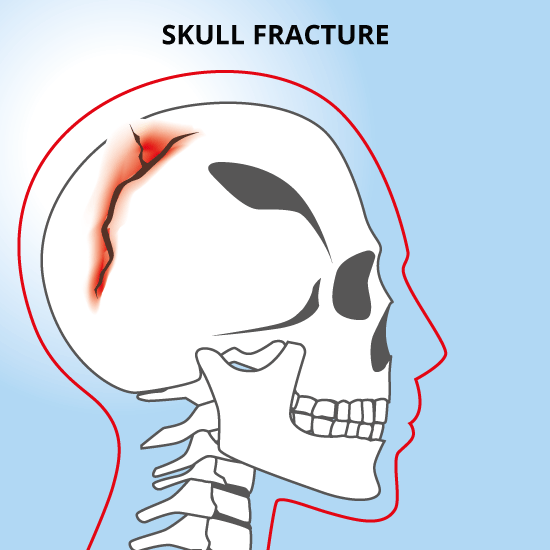Head Injuries
Head injuries is a group of various traumas of the head. Head injuries symptoms directly depend on the severity and type of trauma (concussion, skull fracture, etc). Head injuries treatment is also dictated by the severity of the trauma and may include a wide range of measures. Below we are going to discuss this group of condition in more details.
Any injury to your brain, skull, or scalp is considered head injury. Injuries can range from a bruise or a mild bump to a traumatic brain injury. The consequences and treatments of head injuries may vary greatly as it depends on what caused your head injury and how severe it is. A closed head injury is when an injury to the head doesn’t break the skull. An open head injury is an injury to the head that breaks the skull and enter the brain It is difficult to assess how serious a head injury is just by looking. This is because some minor head injuries may bleed a lot while some major injuries don’t bleed at all – which is why all head injuries should be treated seriously and get them assessed. Head injuries can be divided into 2 categories based on what caused them:
- Head injuries due to blows to the head
- Head injuries due to shaking

Head injuries caused by shaking can occur any time you experience violent shaking. However, they are most common in infants and small children. Head injuries caused by a blow to the head are usually associated with:
- Motor vehicle accidents
- Falls
- Physical assaults
- Sports-related accidents
In most cases, your skull will protect your brain from serious harm.
What are the different types of head injuries?
- Hematoma: A collection or clotting of blood outside the blood vessels. This injury can be serious if it occurs in the brain. Consciousness may be lost due to build-up of pressure inside your skull.
- Hemorrhage: Uncontrolled bleeding. Bleeding may occur in the space around your brain (subarachnoid haemorrhage). This will often cause headaches and vomiting. The other type of haemorrhage is when bleeding occurs within your brain tissue (intracerebral haemorrhage). The severity depends on how much bleeding there is. Over time, any amount of blood can cause pressure to build.
- Concussion: Occurs when your brain bounces against the hard walls of your skull. Generally, the loss of function associated with concussions is temporary. With that said, repeated concussions can eventually lead to permanent damage.
- Edema (swelling): Any form of brain injury can lead to edema or swelling. Head injuries may cause swelling of the surrounding tissues; it’s more serious when it occurs in your brain. The skull will not be able to stretch to accommodate for the swelling. This leads to a build-up of pressure in your brain and can cause your brain to press against your skull.
- Skull Fracture: The skull doesn’t have bone marrow, unlike the other parts of your body – which makes the skull very strong and difficult to break. A broken skull will be unable to absorb impact; this makes it more likely for damage to reach your brain.
- Diffuse Axonal Injury (sheer injury): One of the most dangerous types of head injuries. It can lead to permanent brain damage and even death. An injury to the brain that doesn’t cause bleeding but damages brain cells.

Head injuries symptoms
The symptoms may vary from almost none-existent to loss of consciousness and coma. Some symptoms may not necessarily occur immediately at the time of injury. It may take time for swelling or bleeding to occur to cause show recognizable symptoms. Initial symptoms may include a change in mental status; which means there is an alteration in the wakefulness of the patient. There may also be loss of consciousness, lethargy and confusion. Symptoms may also include:
- Vomiting
- Difficulty tolerating bright lights
- Cerebrospinal fluid leaking from the ear or nose
- Bleeding from the ear
- Speech difficulty
- Paralysis
- Difficulty swallowing
- Body numbness
Other symptoms may be more subtle and include:
- Nausea
- Dizziness
- Irritability
- Difficulty concentrating and thinking
- Amnesia
Later signs of significant head injury and raised pressure within the brain and skull are:
- Dilated pupil
- High blood pressure
- Low pulse rate
- Abnormal breathing pattern
If the patient doesn’t awaken completely and is defined as a prolonged episode of loss of consciousness, it is considered as coma.
HEAD INJURIES TREATMENT OPTIONS
Minor head injuries often show no symptoms other than pain at the area of the injury. You may be told to take acetaminophen (Tylenol) for the pain. Nonsteroidal anti-inflammatory drugs (NSAIDs) such as ibuprofen or aspirin shouldn’t be taken as they can make bleeding worse. Open cuts will be fixed using sutures or staples to close it and will be covered with a bandage. Minor head injuries shouldn’t be dismissed. It is important to see a doctor to monitor your condition to make sure it doesn’t get worse. It isn’t true that you shouldn’t fall asleep after a head injury butyou should be woken up every 2 hours or so to check for new symptoms. Go back to the doctor if you develop any new or worsening symptoms. Serious head injury will require hospitalization and treatment will depend on your diagnosis. Treatment for severe head injuries can include:

Medication
You may be given anti-seizure medication as you’re at risk for seizures in the week following your accident. Diuretics may be prescribed if your injury has caused a build-up of pressure in your brain. This drug causes you to excrete more fluids – this can help to relieve some of the pressure. You may be given medication to put you in an induced coma if the injury is extremely serious – an appropriate treatment if blood vessels are damaged. During a coma, the brain doesn’t require as much oxygen and a nutrient as it normally does.
Surgery
An emergency surgery may be required to prevent further damage to your brain. For instance, doctors may need to operate to remove a hematoma, repair the skull or release some of the pressure in the skull.
Rehabilitation
You will most likely need rehabilitation to regain full brain function if you’ve experienced a serious brain injury. Depending on what functionality you have lost as a result of your injury, your type of rehabilitation will vary. Generally, patients need help regaining mobility and speech.
DIAGNOSING HEAD INJURIES
- Consult with doctor and physical examination: The Glasgow Coma Scale (GCS) is 1 of the first ways your head injury will be assessed. GSC is a 15-point test that assesses your mental status. Receiving a high GCS score indicates a less severe injury.When someone has suffered from a head injury, they won’t remember details of the accident. Your doctor will require information on the circumstances of your injury. Thus, you should always bring someone with you who witnessed the accident if possible as it will be vital for your doctor to determine if you lost consciousness and if you did, for how long.You may also be examined to look for signs of trauma, including bruising and swelling. A neurological examination is also likely to be ordered. Your doctor will evaluate your nerve functions by assessing muscle control and strength, eye movement, and sensation, amongst other things.
- Imaging tests: Commonly used to diagnose head injuries. CT scans help to look for fractures, evidence of bleeding and clotting, brain swelling and any other structural damage. These scans are fast and accurate which typically makes them the first type of imaging you will receive. An MRI scan may also be performed. This scan offers a more detailed view of the brain. This san is normally performed once the patient’s condition has been stabilized.


